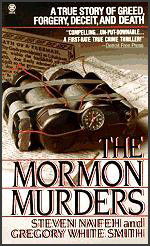| “ | When I was about 12 years old I began collecting coins. Soon afterwards I figured out some crude ways to fool other collectors by altering coins to make them appear more desirable. By the time I was 14 I had developed a forgery technique which I felt was undetectable. I exuded in impressing other collectors and dealers with my rare coins. Money was not the object. | ” |
— Hofmann
| ||
Mark William Hofmann is a convicted con artist-turned-serial bomber and spree killer who is widely regarded by many as one of the most accomplished forgers in American history.
Background[]
Born on December 7, 1954, in Salt Lake City, Utah, Hofmann was raised by devoutly-religious parents and was reared in The Church of Jesus Christ of Latter-day Saints, or the LDS Church. Though he performed below average in high school, he excelled in the hobbies he took, which included magic, electronics, chemistry, and stamp and coin collecting. He also constructed several bombs with his friends in the outskirts of Murray, Utah, for "fun". One day, Hofmann forged a rare mint mark on a dime, which he later gave to an organization that believed it was legitimate. Like many other men in the LDS Church, he voluntarily spent two years as a Mormon missionary; in 1973, he was sent to the England Southwest Mission, who stationed him in Bristol, England. There, Hofmann perused No Man Knows My History, a non-hagiographic biography of LDS Church founder Joseph Smith, Jr. written by Fawn Brodie, as well as purchasing early Mormon material and books that critiqued the LDS Church. When he was fourteen years old, he allegedly lost his faith in the LDS Church. Returning to the U.S. from his mission, he enrolled as a pre-med major at Utah State University. Sometime in 1979, he met and married Doralee Olds, having four children with her; she later filed for divorce eight years afterward.
Criminal Career[]
The Forgeries[]
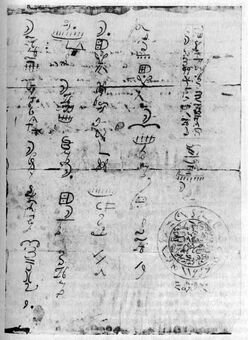
The forged Reformed Egyptian.
In 1980, Hofmann alleged that he had discovered a 17th-century King James Bible with a folded paper inside; it appeared to be a transcript that Joseph Smith, Jr.'s scribe Martin Harris had presented to Charles Anthon, a Columbia classics professor, in the year of 1828. According to a Mormon scripture called Joseph Smith—History, the transcript, and its unusual "reformed Egyptian" characters were copied by Smith from the Mormon golden plates from which he translated the Book of Mormon. However, in reality, Hofmann had constructed a fake King James Version to fit Charles Anthon's description of the document, and its "discovery" led to his reputation. Nevertheless, it was concluded by experts that the document was indeed legitimate. In April, the LDS Church announced the discovery of the Anthon Transcript and purchased it from Hofmann for more than $20,000. Hofmann promptly dropped out of school and went into business as a dealer in rare books, fabricating other historically-significant documents and became noted for his "discoveries" of previously-unknown materials that pertained to the Latter Day Saint movement. These forgeries tricked not only members of the highest Mormon governing body the First Presidency, but also document experts and distinguished historians. Hofmann's motives for the forgeries seemed to be not only from greed but also by "the desire to embarrass the church by undermining church history".
In 1981, Hofmann arrived at the LDS Church headquarters, possessing a forged letter that allegedly provided evidence that Joseph Smith, Jr., had designated his son Joseph Smith III, rather than settler Brigham Young, as his successor. The letter, apparently written by Mormon pioneer Thomas Bullock and dated January 27, 1865, Bullock chastised Brigham Young for having all copies of Joseph Smith III's blessing destroyed, also writing that although he believed Young to be the legitimate leader of the LDS Church, he would keep his copy of the blessing. In February, Hofmann attempted to sell the letter to the chief archivist of the LDS Church, but when he was turned down due to the price, he offered it to the Missouri Church, the Reorganized Church of Jesus Christ of Latter Day Saints, which had always claimed that the line of succession had been bestowed on Joseph Smith, Jr.'s line, but never had any written proof. A scramble to acquire the Blessing occurred as a result, and Hofmann, posing as a faithful Utah Mormon, presented it to his church in exchange for items worth more than $20,000. However, he also ensured that the document would be made public knowledge; the following day, a New York Times headline read, "Mormon Document Raises Doubts on Succession of Church's Leaders", and the LDS Church promptly confirmed the discovery and publicly presented the document to the RLDS Church. After Hofmann's arrest, it is believed that after he had successfully forged the so-called Blessing of Joseph Smith III, he would create the "lost 116 pages" of the Book of Mormon, which he potentially could've filled with inconsistencies and errors, sell them to the church so they could be hidden away, and then ensure that the contents were made public.
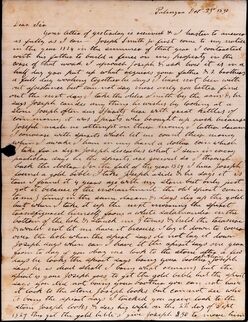
The Salamander letter, pg. 1.
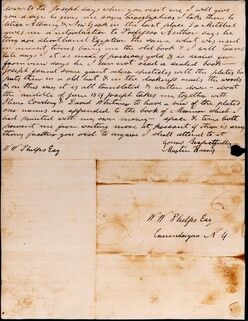
The Salamander letter, pg. 2.
Hofmann later created his best-known forgery, called the Salamander letter, which first appeared in 1984. Supposedly written by Martin Harris to early Mormon convert W.W. Phelps, it presented a version of the recovery of the gold plates that was completely inaccurate to the church's version of events. It also stated that Joseph Smith, Jr., had been practicing "money digging" through magic; that he used a seer stone; and that the angel Smith said had appeared to him was, in actuality, a white salamander (thus the name of the letter) who demanded the presence of Smith's brother Alvin, who was dead at the time of the event. After the letter had been purchased for the church and become public knowledge, Apostle Dallin Oaks asserted to Mormon educators that the words "white salamander" could be reconciled with Smith's Angel Moroni since in the 1820s, the word salamander might also refer to a mythical being thought to be able to live in fire, also called a "salamander". The letter was offered to a number of interested parties, including prominent critics of the LDS Church, Jerald and Sandra Tanner, who expressed doubts as to its authenticity; a deal with the LDS Church was never reached. Hofmann finally sold the letter to Steven Christensen on January 6, 1984, for $40,000. Later, the Tanners ironically became the first to declare the letter a forgery, although the letter was judged to be legitimate. Nevertheless, people began to place suspicion on Hofmann for creating forgeries, since it was statistically impossible for him to make so many "discoveries" of astounding documents.
The Bombings[]
"As I look back on the decisions made during this time of panic, I can see many forms of rationalization which I employed. For example, for the first time in my life I took an interest in reading the obituaries. I believe that I was trying to convince myself of the worthlessness of life and of life's unfairness. I told myself that my survival and that of my family was the most important thing. That my victims might die that day in a car accident or from a heart attack anyway. I thought about the Nazi Holocaust, the earthquake in Mexico, and other disasters."
In addition to forging historical Mormon documents, Hofmann had also forged and sold signatures of many famous non-Mormons, including that of U.S. Constitution signatory Button Gwinnett, which was considered extremely rare and valuable. He also forged the Oath of a Freeman, the most famous missing document in American colonial history. It was printed in 1639, the first document to be printed in Britain's American colonies, but only about fifty copies had been made, none of which were extant, and a genuine example was considered to be worth over a million dollars in 1985. However, Hofmann was in debt, despite the considerable amounts of money he made from the document sales, because of his increasingly lavish lifestyle and his purchases of first-edition books. In an effort to clear his debts, he attempted to broker a sale of the "McLellin collection", which was a supposedly extensive group of documents written by early Mormon apostle William E. M'Lellin. He hinted that the McLellin collection would provide revelations that would prove to be unfavorable in the views of the LDS Church. Unfortunately for him, he didn't have any idea as to where the McLellin collection was, and he didn't have the time to create a suitable forgery. In addition, Hofmann received mounting pressure from people to whom he had promised the document collection or repayments of debts, all of whom began to hound him, and the sale of the Oath of a Freeman was delayed by questions about its authenticity. In order to buy himself more time, he decided to commit his bombing spree.
On October 15, 1985, Hofmann sent a bomb to Steven Christensen, which exploded on the sixth floor in the Judge Building, which was located in the business district of Salt Lake City, just after 8:00 a.m. Christensen was killed just outside of his office, and a nearby secretary was wounded in the leg by flying glass. Coinciding with the bombing were the crimes committed by serial bomber Theodore Kaczynski, a.k.a. "The Unabomber". Because Kaczynski hadn't claimed any lives at the time of Hofmann's first bombing, no one in Salt Lake City was sure if this was his work or not. Police and firefighters responded to the scene of the bombing and found Christensen's body, which remained unidentified at the time due to the severe wounds it sustained. The Bureau of Alcohol, Tobacco, Firearms and Explosives, or the ATF, immediately took supervision of the investigation. Meanwhile, at Holladay, Utah, Hofmann sent a bomb to J. Gary Sheets, Christensen's former employer, with the intention of killing him, but Sheets' wife Kathy picked up the bomb; at the time, Sheets was, ironically, at the Judge Building in the aftermath of the first bombing. The second bomb exploded at approximately 9:30 a.m., killing Kathy. At first, police suspected the bombings to have been started by the impending collapse of CFS Financial Corporation, a real-estate investment business that was founded by Sheets and employed Christensen, who recently left after it lost investors a lot of money. It was also assumed by document dealers that this could have been the work of Mormon fanatics who had learned about the Salamander letter, which severely damaged the church's reputation and credibility, as well as having feared the discovery of a document that would verify past rumors that Joseph Smith had been a "money-digger", meaning that he had asked farmers to pay money to him so he could wander over their land with the "seer stone" that he used to locate buried treasure.
The following day, Hofmann severely injured himself after detonating a bomb in his own Toyota sports car in front of the Deseret Gymnasium in Salt Lake City; he suffered gashes on his face and chest, a number of burns on his right side, a missing finger and kneecap, and a metal piece embedded in his knee, among other wounds. He was rescued by three bystanders and taken to a hospital. When interviewed by police, Hofmann alleged that he was about to meet with an attorney who represented a man to whom he was selling some documents, and that he had gone to his car and saw a package on the seat, which detonated after he opened the door and accidentally caused the package to fall off of the seat. He also said that a brown pickup truck was following him that morning, with a middle-aged Caucasian man driving, and that he didn't see the truck by the time he arrived at his destination. In the wake of the bombing that "targeted" Hofmann, investigators assumed that it wasn't the discovery of the Salamander letter that triggered the bombing spree, but possibly the discovery of the McLellin collection. However, police became suspicious of Hofmann when it turned out that he had appointments with both Steven Christensen and J. Gary Sheets over the McLellin collection, which were set to take place exactly on the day of the two fatal bombings. The remains of Hofmann's car were kept as evidence, and a bomb expert who inspected the car concluded that, at the time of the explosion, the bomb had been on the right side of the seat where it was left, tilted against the console that separated the front seats, and that it didn't fall to the floor. Therefore, it was more probable that Hofmann had picked up and dropped the bomb by mistake, instead of the bomb dropping out of the seat on its own accord as he told police. Additionally, had the bomb been on the floor when it detonated, it would've exploded downward; the door would have to be ajar, otherwise, Hofmann would have been propelled through the roof by the blast. The bomb expert also concluded that the bomb was likely located in the backseat of the car; Hofmann had knelt on the seat as he reached into the back to arm it and pick it up, but mistakenly moved it the wrong way or jarred it, setting the detonation into motion.
Arrest, Trial, and Incarceration[]
With Hofmann being named the perpetrator of the bombings, his car was further searched. A search of the trunk's remains turned up a pipe-elbow of the same material used to construct the three bombs, a black magic marker (which matched the ink of the writing found on the other two bomb packages), a pair of rubber surgical gloves, a crinkled piece of paper, and numerous other papers that were burned by the fire and drenched from the fire-hoses. Also, witnesses questioned at the scene confirmed that Hofmann was inside the car when the bomb detonated, not outside as he claimed to police; a woman even said that she had seen him lift something up from behind the front seat on which he was kneeling. A search was conducted inside Hofmann's house, which recovered a tape recorder, some gun parts, and an Uzi submachine gun operation manual, as well as evidence that Hofmann forged the documents he discovered. They also dismantled the home's security system since its parts could have been used in the manufacture of the bombs. Document examiner George Throckmorton analyzed several of Hofmann's documents that were previously deemed authentic, determining that they were indeed forgeries. He also discovered that some of them documents, stated to have been written by different people, possessed similar writing styles and that they had been written with homemade iron gall ink that looked cracked, much like alligator skin, under a microscope, although authentic period ink did not. Investigators also discovered that a poem used to authenticate the handwriting in the Salamander letter was forged by Hofmann as well and then inserted in a Book of Common Prayer that was once owned by Martin Harris.
As a result of these discoveries, Hofmann was arrested for murder and forgery in February 1986. He initially maintained his innocence, but rather than risk the death penalty, he, on January 1987, plead guilty to two counts of second-degree murder and two counts of theft by deception, confessing to his forgeries in open court. On January 1988, he was sentenced to five years to life in prison. He nearly received parole in 1988, but the Utah Board of Pardons, observing Hofmann's "callous disregard for human life", concluded that he should never receive another chance of parole. After Hofmann was imprisoned, his wife filed for divorce. He then attempted suicide in his cell by taking an overdose of antidepressants, but was revived. However, he had spent twelve hours lying on his right arm, blocking its circulation and causing muscle atrophy, ironically permanently disabling the hand he used to forge his documents. In the following years, Hofmann was recognized as one of the most accomplished forgers in American history, with collectors continuing to purchase and sell his forgeries as if they were genuine, even as late as 1997. In August 1987, the sensationalist aspects of Hofmann's case led Mormon apostle Dallin Oaks to believe that church members witnessed "some of the most intense LDS Church-bashing since the turn of the [20th] century". A Mormonism student, Jan Shipps, also agreed to Oaks' statement, citing that press reports "contained an astonishing amount of innuendo associating Hofmann's plagiarism with Mormon beginnings. Myriad reports alleged secrecy and cover-up on the part of LDS general authorities, and not a few writers referred to the way in which a culture that rests on a found scripture is particularly vulnerable to the offerings of con-artists."
As of 2016, Hofmann is incarcerated at Central Utah Correctional Facility in Gunnison.
Modus Operandi[]
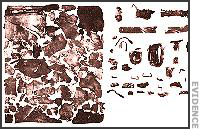
A reassembly of one of Hofmann's bombs using leftover fragments.
Whenever he killed, Hofmann used homemade bombs that were concealed in packages. They made from metal pipes, wires, and a battery pack, and detonated through a mercury switch, smokeless gunpowder, and a model-rocket ignition device, which would be set off when the mercury switch was put in contact with the battery pack while being picked up. Nails were used as shrapnel for the Judge Building bomb.
Known Victims[]
- October 15, 1985:
- Salt Lake City, Utah: The Judge Building bombing:
- Steven Christensen (the man who purchased the Salamander letter)
- Unnamed secretary (injured in the leg by flying glass; survived)
- Holladay, Utah: The Sheets house bombing:
- J. Gary Sheets (Steven Christensen's ex-employer; intended)
- Kathleen Sheets (J. Gary Sheets' wife; incidental)
- Salt Lake City, Utah: The Judge Building bombing:
On Criminal Minds[]
- Season One
- "Won't Get Fooled Again" - While Hofmann was never directly mentioned or referenced on the show, he appears to have been the primary inspiration for the episode's unsub, David Walker - Both were con artists-turned serial bombers and spree killers who were married and worked in antiquities, had heavy debts from their forgeries as stressors, resorted to using bombs concealed in packages to murder people when suspicion was being placed on their activities, killed two victims, one intended and one as collateral, and had bombs with distinctive ink on their packaging labels that detonated through a mercury switch when people picked them up. Also, the BAU initially suspecting Walker's second victim of being the unsub seems to be extremely reminiscent of the circumstances behind Hofmann's apprehension, in which he severely injured himself with one of his own bombs as he apparently attempted to deliver it; in addition, Walker copying Adrian Bale could reflect how Hofmann's bombings were originally presumed to have been by Theodore Kaczynski, a.k.a. "The Unabomber", while he was still at large.

